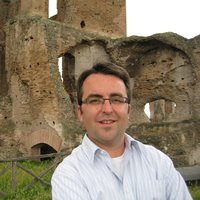Wabash professor explores photography's impact on Pompeii excavation, Oct. 5
Jeremy Hartnett focuses on excavation of ancient Roman street

The excavation of an ancient street in Pompeii is the subject of an upcoming lecture at Syracuse University. Jeremy Hartnett, assistant professor of classics at Wabash College (Indiana), will present “Excavation Photographs and the Rediscovery of the Via dell’Abbondanza at Pompeii” on Wednesday, Oct. 5, at 5:30 p.m. in the Peter Graham Scholarly Room on the first floor of Bird Library. The event, which is free and open to the public, is sponsored by the Syracuse Society of the Archaeological Institute of America (AIA), in conjunction with The SU Humanities Center. For more information, contact Gloria Hunt at grhunt@syr.edu.
Hartnett’s presentation centers on Vittorio Spinazzola, an Italian archeologist who excavated Pompeii from 1911 to 1923, and was among the first to use photography to scientifically record the unearthing process. Known for his careful, systematic work, Spinazzola devoted considerable time to unearthing and restoring portions of a main thoroughfare called the Via dell’Abbondanza (Street of Abundance). The result was an exposed patchwork of paintings, graffiti, facades, and balconies that revealed life in this Roman town, annihilated by a volcanic eruption in A.D. 79.
Spinazzola spent the end of his life publishing a book about the excavation, containing more than 600 photographs and two dozen lithographs. Allied bombings during World War II destroyed not only the publishing house—along with every single copy of Spinazolla’s book--but also large portions of the Via dell’Abbondanza, making Spinazzola’s archival efforts all the more enlightening.
The first part of Hartnett’s lecture considers how the use of photography has changed the presentation of the excavator and his work. The second part concentrates on Spinazzola’s excavations and what they reveal about life along one of the most colorful and vibrant streets of Pompeii.
A Wabash faculty member since 2006, Hartnett specializes in Herculaneum, Pompeii, and the Bay of Naples; Greek and Roman art and archeology; architecture and urbanism; and Latin language and literature. He is the author of numerous scholarly publications, including the forthcoming book, “Streets and Society in Pompeii and Herculaneum.” He earned a Ph.D. in classical art and archeology from The University of Michigan.
The SU Humanities Center, founded in 2008, fosters public engagement in the humanities, and is home to the Syracuse Symposium, the Central New York Humanities Corridor, the Jeanette K. Watson Distinguished Visiting Professorship and Visiting Collaborator programs, the HC Mini-Seminar and Symposium Seminar series, the Perpetual Peace Project, and other annual research initiatives, annual fellowships, and public programming.
The AIA promotes a vivid and informed public interest in the cultures and civilizations of the past, supports archaeological research, fosters the sound professional practice of archaeology, advocates the preservation of the world’s archaeological heritage, and represents the discipline in the wider world. All archaeology enthusiasts in the Syracuse area are encouraged to join the newly-formed Syracuse Society of the AIA, which provides lectures and publications on archaeology around the world.
Hartnett’s presentation centers on Vittorio Spinazzola, an Italian archeologist who excavated Pompeii from 1911 to 1923, and was among the first to use photography to scientifically record the unearthing process. Known for his careful, systematic work, Spinazzola devoted considerable time to unearthing and restoring portions of a main thoroughfare called the Via dell’Abbondanza (Street of Abundance). The result was an exposed patchwork of paintings, graffiti, facades, and balconies that revealed life in this Roman town, annihilated by a volcanic eruption in A.D. 79.
Spinazzola spent the end of his life publishing a book about the excavation, containing more than 600 photographs and two dozen lithographs. Allied bombings during World War II destroyed not only the publishing house—along with every single copy of Spinazolla’s book--but also large portions of the Via dell’Abbondanza, making Spinazzola’s archival efforts all the more enlightening.
The first part of Hartnett’s lecture considers how the use of photography has changed the presentation of the excavator and his work. The second part concentrates on Spinazzola’s excavations and what they reveal about life along one of the most colorful and vibrant streets of Pompeii.
A Wabash faculty member since 2006, Hartnett specializes in Herculaneum, Pompeii, and the Bay of Naples; Greek and Roman art and archeology; architecture and urbanism; and Latin language and literature. He is the author of numerous scholarly publications, including the forthcoming book, “Streets and Society in Pompeii and Herculaneum.” He earned a Ph.D. in classical art and archeology from The University of Michigan.
The SU Humanities Center, founded in 2008, fosters public engagement in the humanities, and is home to the Syracuse Symposium, the Central New York Humanities Corridor, the Jeanette K. Watson Distinguished Visiting Professorship and Visiting Collaborator programs, the HC Mini-Seminar and Symposium Seminar series, the Perpetual Peace Project, and other annual research initiatives, annual fellowships, and public programming.
The AIA promotes a vivid and informed public interest in the cultures and civilizations of the past, supports archaeological research, fosters the sound professional practice of archaeology, advocates the preservation of the world’s archaeological heritage, and represents the discipline in the wider world. All archaeology enthusiasts in the Syracuse area are encouraged to join the newly-formed Syracuse Society of the AIA, which provides lectures and publications on archaeology around the world.
Media Contact
Rob Enslin
